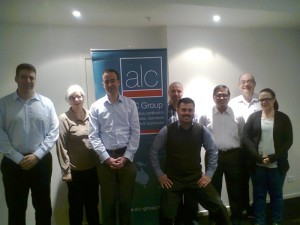ITIL IRL… Tales From Singapore.
 | On Saturday, I bought a new table fan. The old one was beyond economic repair and had died sometime during the night. It was old and getting clogged with long dark hair (not mine, obviously) and cigarette ash (mine, of course) but I was loath to replace it because it looked so stylish and was a gift from a good friend. The new one is cheap and quite ugly but at least it works. On Sunday, it suddenly stopped. Well, how else would a fan stop? “&^%%$% marvellous! MTBSI of one day! Typical!” thought I. |
I fiddled with it and prodded it as all the best technicians do. No joy.
Then it occurred to me… wasn’t the light on in the other room? Ah, yes! And my laptop is now running off battery.
OK, time for some proper Incident Management.
Identification: Loss of power. But to what extent?
Category: Power failure limited to my apartment only (I can hear the TV throbbing next door)
Priority: One. Obviously. Anything that happens to me is priority one… by default!
 But whether my Service Desk will agree, who knows? I will mention, when I report it, that I will be calculating the cost of the food defrosting in the freezer. That should raise the Urgency if not the Impact.
But whether my Service Desk will agree, who knows? I will mention, when I report it, that I will be calculating the cost of the food defrosting in the freezer. That should raise the Urgency if not the Impact.
Even though I have not reported the Incident yet and it hasn’t been logged (hey! I’m the user not the Service Desk), I decide that it’s worth doing some ‘initial diagnosis’ to save some time later.
I have an Incident Model for this one. It involves checking the switches in the fuse-box-thingy in the kitchen. There is a blue switch and a big, red one and lots of small black ones and they are supposed to be in the ‘up’ position. The blue one is down.
I flick the switch but it chooses to resist. I flick the others down, flick the blue one up (it acquiesces) and then systematically (because I have been trained well) flick the others up too. I discover that the truculent switch is the big, red one. I don’t know what this big, red switch does but it looks kinda important.
Time to get this one logged. But by whom? Who is my single point of contact?
I try one of the two agents (who have not, to date, performed well regarding response-targets). SingTel inform me that the number is unreachable.
I escalate to the Landlord. SingTel inform me that the number is also unreachable. I begin to wonder whether SingTel have a big, red switch too.
Next thing… an alert! Actually, it was just the doorbell.
The apartment is split level and is divided in two. I have the lower part and the agent had earlier informed me that the upper part has been recently occupied by “a lovely, Korean lady”. The electricity is shared.
She is at the door and I instantly confirm that she is Korean. Her English is understandable and … my Korean is non-existent.
I show her the switch box and try to explain (by waving my hands a bit) that I am attempting to get the incident logged.
Another alert (her phone). While she is talking I send an SMS to the other agent but then realise that that was not best practice; a priority one requires personal and personnel attention.
I hear the Korean lady say “all broken electronics”… she has had more luck than I in contacting one of our many ‘single’ points of contact. She hands the phone to me and I attempt to explain what diagnosis I have performed so far. I have no idea who I am speaking to but the lady at the other end thanks me and says she will contact agent #1 (which makes him sound like a James Bond character… probably a villain).
The Korean lady goes back upstairs and all I can do is wait. It occurs to me that I am unaware of any SLA but while I am pondering, Agent#1 sends a text. I realise that the lady on the phone didn’t write down what I said or more likely something was lost in translation because I have limited Singlish.
My mind goes back to all the time and effort expended over the years trying to get my Service Desk staff to accurately document their conversations and all those meetings with technical and application managers apologising for the lack of pertinent information (meaning they usually had to call the users themselves) and begging them to write ‘scripts per category’ so that the right questions can be asked during the logging stage.
This is the brief SMS exchange with Agent#1:
Agent#1: DLJ, off all small circuit. Up the blue one first, then red one, then the rest 1 by 1.
DLJ: Ok
…
DLJ: I off’d all small ones. Up’d the blue one. Up’d the red one and the blue one trips.
Agent#1: Ok
…
Agent#1: Electrician will come in 1 hours time. [sic]
DLJ: Thanks. Can you please let the tenant upstairs know that too? Cheers.
I’m not convinced these agents have had their ITIL training yet so I’m covering the bases by assuming the role of Incident Manager in charge of co-ordinating communication to all users (it has to be me; my flatmates have abandoned me like users going to lunch when their email is down) but at least I now know there is an Underpinning Contract for a Service-based SLA.
And actually, I’m impressed… I would never have been able to get an electrician to come out on a Sunday when I was back in the UK.
20 minutes later (yes, really), the engineer arrives and does what engineers do best: fiddle with things, suck their teeth, slowly shake their heads and ignore the user’s irritating questions.
I get him access to the flat above … and then leave him to his Investigation and Diagnosis.
He finds the cause (not the root cause because, as we all know, that’s Problem Management’s job) which is the Korean lady’s water heater for her shower and in my role as Incident Manager I keep Agent#1 updated.
So now the power is back on and my incident can be closed. The Korean lady’s incident remains open. There is a ‘workaround’ but I resisted the temptation to offer her my shower… maybe when we got to know each other better.
All in all the whole things was not too far from ITIL’s best practice. I even avoided behaving like the typical user, in 2 ways:
-
I resisted the temptation to ask for the engineer’s contact number so that I could bypass the service desk next time.
-
I didn’t say to the engineer “while you are here….” and get him to find out why the TV hasn’t been working for the past month… but that was only because he disappeared before I got the chance.
I guess the TV is a P5.
Sigh!



















 But whether my Service Desk will agree, who knows? I will mention, when I report it, that I will be calculating the cost of the food defrosting in the freezer. That should raise the Urgency if not the Impact.
But whether my Service Desk will agree, who knows? I will mention, when I report it, that I will be calculating the cost of the food defrosting in the freezer. That should raise the Urgency if not the Impact.
